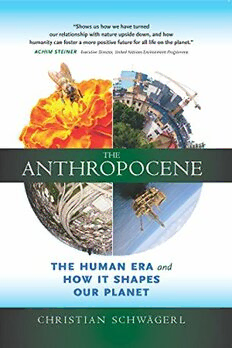
The Anthropocene: The Human Era and How It Shapes Our Planet PDF
Preview The Anthropocene: The Human Era and How It Shapes Our Planet
“Shows us how we have turned our relationship with nature upside down, and how humanity can foster a more positive future for all life on the planet.” Achim Steiner Executive Director, United Nations Environment Programme the anthropoCene the human era and how it shapes our planet C h r i s t i a n s C h wäg e r l THE anTHropocEnE THE anTHropocEnE THE Human Era and How IT SHapES our planET cHrISTIan ScHwägErl Foreword by Paul J. Crutzen Translated from German by Lucy Renner Jones synergetic press Santa Fe & London © Copyright 2014 by Riemann Verlag. All rights reserved. English translation © copyright 2014 by Synergetic Press. Foreword © copyright by Paul Crutzen, 2011, 2014. No part of this publication may be reproduced, stored in any retrieval system, or transmitted, in any form or by any means, electronic, mechanical, photocopying, recording, or otherwise without the prior permission of the publisher, except for the quotation of brief passages in reviews. Published by Synergetic Press 1 Bluebird Court, Santa Fe, NM 87508 24 Old Gloucester St., London WC1N 3AL Original title: Menschenzeit. Zerstören oder gestalten? Die entscheidende Epoche unseres Planeten, by Christian Schwägerl, © 2011 by Riemann Verlag, a division of Verlagsgruppe Random House GmbH, Munich, Germany Library of Congress Cataloging-in-Publication Data Schwägerl, Christian. [Menschenzeit. English] The anthropocene : the human era and how it shapes our planet / Christian Schwägerl. pages cm ISBN 978-0-907791-54-6 (hardcover) -- ISBN 0-907791-54-9 (hardcover) -- ISBN 978- 0-907791-55-3 (pbk.) -- ISBN 0-907791-55-7 (pbk.) 1. Environmental responsibility. 2. Environmental ethics. 3. Nature--Effect of human beings on. I. Title. GE195.7.S3413 2014 304.2--dc23 2014034709 Book and cover design by Barbara Haines Editors of the English language edition, Linda Sperling with Hugh Elliot Translated from German by Lucy Renner Jones Printed by Global PSD, USA on 55# Glatfelter White D-37 stock Typefaces: Minion with Scala Sans display conTEnTS Foreword by Paul J. Crutzen vii Preface ix prologue Writing in the Sky 1 one Welcome to the Club of Revolutionaries 11 two The Long March 22 three The End of the Holocene 31 four Signals of Earth Time 49 five Apocalypse “No” 70 six The Evergreen Revolution 86 seven The Invir0nment 106 eight Technature 127 nine Directing Evolution 150 ten Earth Economy 174 eleven Action Potentials 191 twelve Anthropocene Day 206 epilogue Deep Future 219 Acknowledgments 228 Glossary 229 forEword t his book is a striking manifestation of the power and poten- tial in the idea of the Anthropocene. A skillful narrator with many years of journalistic experience, author Christian Schwägerl describes how a single species, our own, is irreversibly transforming the Earth’s biological, geological and chemical processes, and thus affect- ing our very existence. Two hundred years of industrialization bear testi- mony to humanity’s power of innovation and creativity but also prove our more perilous powers of degradation and destruction. For the first time in Earth’s history, its future is being determined by both the conscious and unconscious actions of Homo sapiens. Schwägerl’s book is a rallying cry for us to recognize our opportunity to build a long-lasting, viable, creative and freedom-loving human civilization. This book is like a navigation sys- tem for the new world of the Anthropocene that lies before us. Paul J. Crutzen, PhD Dr. Paul J. Crutzen, born 1933, is an atmospheric chemist who won the Nobel Prize for Chemistry (with Mario J. Molina and Frank Sherwood) in 1995, for his pioneering research into ozone layer depletion caused by chlorofluoro- carbons (CFCs). From 1977 to 1980, Dr. Crutzen was the director of research at the National Center of Atmospheric Research (NCAR) in Boulder, Colo- rado and from 1980 to 2000, director of Atmospheric Chemistry at the Max Planck Institute for Chemistry in Mainz, Germany. He has undertaken research at numerous other institutions, such as the Scripps Institution of Oceanography and the Georgia Institute of Technology. Crutzen is a long- standing member of various scientific academies, including the National Academy of Sciences and the American Academy of Arts and Sciences. vii prEfacE I think i came across the word Anthropocene a few times without it making an impression. Then, one day, it really struck me. I was at a lunch with my friend Matthias Landwehr, in 2008, and he told me that this subject was something I should investigate. I agreed to do so. When I got back to my desk, I had an epiphany and my twenty-five years of report- ing on environmental and science issues and forty years of love for every- thing natural suddenly appeared in a new light, as if I had been touched by a magician’s wand. One man, Paul J. Crutzen, had defined the relationship between humans and planet Earth, in such a powerful way, that it was hugely inspiring. Crutzen had melded humans and nature (two entities that I had previously thought of as separate, opposing forces), into a whole new science-driven idea. It described a connection that reaches back into the past and far into the future. After seeing, at first hand rainforests burning, land made toxic from mining, and species on the brink of extinction, this idea gave me hope that our ever evolving human consciousness might be about to enter a new phase. So, this is how I came to write Menschenzeit (The Age of Humans), the German language precursor of what you hold in your hands. Men- schenzeit was launched at the Berlin Museum for Natural History, in September 2010. Achim Steiner, the head of the United Nations Environ- ment Programme, came to Berlin for the occasion and gave a wonderful speech about freedom and responsibility. The book launch also resulted in the beginning of a productive friendship with Reinhold Leinfelder, then director general of the Berlin Natural History Museum. Together, we ix
